The Panthéon is an imposing nineteenth-century building that was first designed as a church, but later turned into a civil temple. Today it is used as a mausoleum for some of France’s most distinguished citizens.


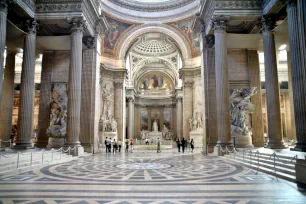
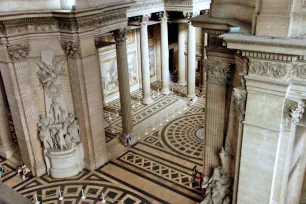
Seated on top of the Mount Ste-Geneviève, not far from the Sorbonne University and the Jardin du Luxembourg, the Panthéon overlooks the Latin Quarter. As far back as 507, this site was chosen by King Clovis – the first Frankish Merovingian King – for a basilica to serve as a tomb for him and his wife Clothilde. In 512 Sainte-Geneviève, patroness of Paris, was buried here.
History
Conception
When King Louis XV suffered from a serious illness in 1744 he vowed to build a church dedicated to Sainte-Geneviève if he would survive. After he recovered, he organized a lottery to gather the necessary funds and entrusted the Marquis of Marigny with the task of building the church. It was to replace the sixth-century Abbey Sainte-Geneviève. In 1755, the Marquis commissioned architect Jacques-Germain Soufflot to design a new, great church that was to rival Rome’s Saint Peter’s basilica and London’s St. Paul’s Cathedral.
Construction
Construction of the imposing building started in 1757. Mainly due to financial problems, it would take more than three decades until the project was completed. After Soufflot’s death in 1780, his associate Guillaume Rondelet took charge of the project. Construction was completed in 1790, in the midst of the French Revolution.
Church or pantheon?
During the French Revolution many churches were closed or converted and the brand-new church of Sainte-Geneviève was no exception. When the Count of Mirabeau – a popular figure during the early days of the revolution – died in 1791, the Constituent Assembly of the Revolution decided by decree to transform the church into a temple to accommodate the remains of the great men of France. Mirabeau was the first one buried here. The building was adapted by architect Quatremère de Quincy to its new function as a pantheon.
After the fall of Emperor Napoleon in 1815 and the restoration of the monarchy, the building became a church again. Just 15 years later, another revolution took place and the building resumed its function as a pantheon. History repeated itself again in 1851 when the future Emperor Napoleon III staged a coup and the building became a church for the last time. It was on the occasion of the burial of Victor Hugo in the Panthéon in 1885 that the building took up its civic role once again.
The Building
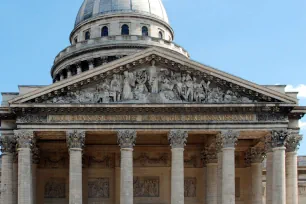
The floor plan shows a Greek-cross layout, 110 meters long and 85 meters wide (361 x 279 ft.).
Exterior
The large dome, which reaches a height of 83 meters (279 ft.), features three superimposed shells, similar to the dome of the St. Paul’s Cathedral in London. Iron reinforcements were added to strengthen the structure even more. The top of the dome is decorated with a large cross instead of a statue of Sainte-Geneviève, as was originally the intention.
The portico, with its large Corinthian columns, was modeled after the Pantheon in Rome. The pediment was originally decorated with religious sculptures which were replaced in 1837 by the current design and features scientists, philosophers, soldiers and even Napoleon Bonaparte.
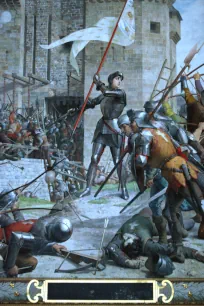
Interior
Paintings
The walls of the Panthéon are decorated with murals that depict the lives of heroes of France. There are several paintings depicting scenes in the life of Joan of Arc, as well as paintings of other historical figures in the history of France such as Clovis – the first king of the Franks and Charlemagne who created the Carolingian Empire in 800 – and Saint Louis, king of France from 1226 until his death in 1270. Patrons of Paris Saint-Denis and Sainte-Geneviève are also celebrated with large murals. The latter, to whom the building was originally dedicated, with a long series that depict important scenes in her life.
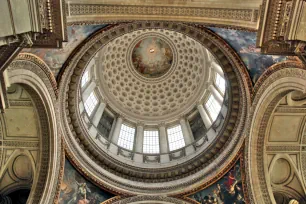
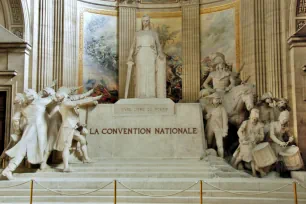
The dome’s ceiling is coffered except for its center, which features a painting entitled «The Apotheosis of Sainte-Geneviève». It was the work of Antoine-Jean Gros, who worked on it from 1811 until 1824. The pendentives (the triangular area between the dome and supporting columns) right below the dome are also decorated with murals depicting Death, Fame, Justice and the Nation.
The semi-dome of the apse of the Panthéon is decorated with a mosaic entitled «Christ Showing the Angel of France the Destiny of Her People».
Sculptures
The apse is also the site of the building’s largest sculpture group, known as the «Altar of the National Convention». It was created by François-Léon Siccard in 1924 and shows the female figure of Marianne representing the Republic. This figure is flanked on the right by revolutionary leader Saint-Just – known as the face of the Reign of Terror – surrounded by soldiers and on the left by deputies swearing an oath to the Republic. The painting behind the altar is from 1905 and represents «Victory leading the Armies of the Republic».
Four more monuments stand in front of the massive pillars that support the dome. One of the largest of these honors Denis Diderot, an important philosopher and author from the Age of Enlightenment. The monument was created in 1913 by Alphonse Terroir and represents Diderot working on his famous encyclopedia. An inscription on the monument states: «The encyclopedia prepares the idea of the Revolution».
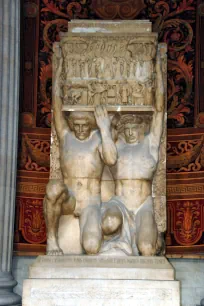
The monument in front of the pillar opposite, across the main aisle, honors Jean-Jacques Rousseau, another renowned philosopher. The monument was created in 1905 by Albert Bartholomé and shows five women: allegorical representations of Music, Truth, Philosophy, Nature and Glory.
Opposite is a monument dedicated to the orators and publicists of the Restoration, the political regime that brought the monarchy back in power after the fall of Napoleon Bonaparte in 1815.
The last of the four monuments in front of the pillars, opposite that of Diderot, is dedicated to the generals of the French Revolution and was created in 1917-1921 by Paul Gasq. It shows Napoleon Bonaparte on horseback, accompanied by his generals.
There are many more sculptures along the walls of the Panthéon. One of the more interesting ones is called «Artists whose names have been lost». It was created by Paul Landowski, a French sculptor of Polish descent best known for his Christ the Redeemer statue in Rio de Janeiro, Brazil.

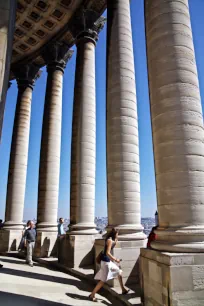
The Crypt
The building’s main function – aside from being a major tourist attraction – is as a mausoleum for France’s most distinguished citizens. Not just any person can be ‘pantheonized’ here: a very select number of just over 80 ‘great people of France’ have been pantheonized. Some of France’s greatest military figures such as Napoleon and Vauban are not entombed here, but in the Invalides.
Most of the remains in the Panthéon are entombed, others are in urns. They can be found in the large crypt below the Panthéon, which covers the whole surface of the building. The entrance is to the left of the apse. Some of the more famous names you’ll encounter in the crypt include Nobel Prize winners Marie & Pierre Curie; authors Victor Hugo and Émile Zola; philosophers Voltaire & Rousseau; Louis Braille, inventor of braille; and the economist Jean Monnet, one of the founding fathers of the European Union.
Foucault’s Pendulum
The Panthéon was the place where, in 1851, the astronomer Jean Bernard Léon Foucault first held his famous experiment, proving that the world spins around its axis. He achieved this by hanging a 28-kilogram weight from the central dome on a 67-meter-long wire.
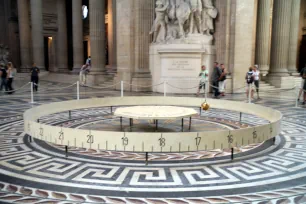
The Foucault pendulum moved in 1855 to the Conservatoire des Arts et Métiers (3e arr). In 1995, it temporarily moved back to the Panthéon due to construction work at the Conservatoire. Today the original pendulum is kept at the Musée des Arts et Métiers, while a working copy is on display in the Pantheon.
Panorama
From the colonnade around the Panthéon’s dome, you have an excellent view over Paris. You will need to climb 203 steps to get there, but you’ll be rewarded with unobstructed 360-degree views. The Panthéon itself is best seen coming from the Jardin du Luxembourg through rue Soufflot.
- Next: Pont Neuf
- More Sights & Attractions in Paris

